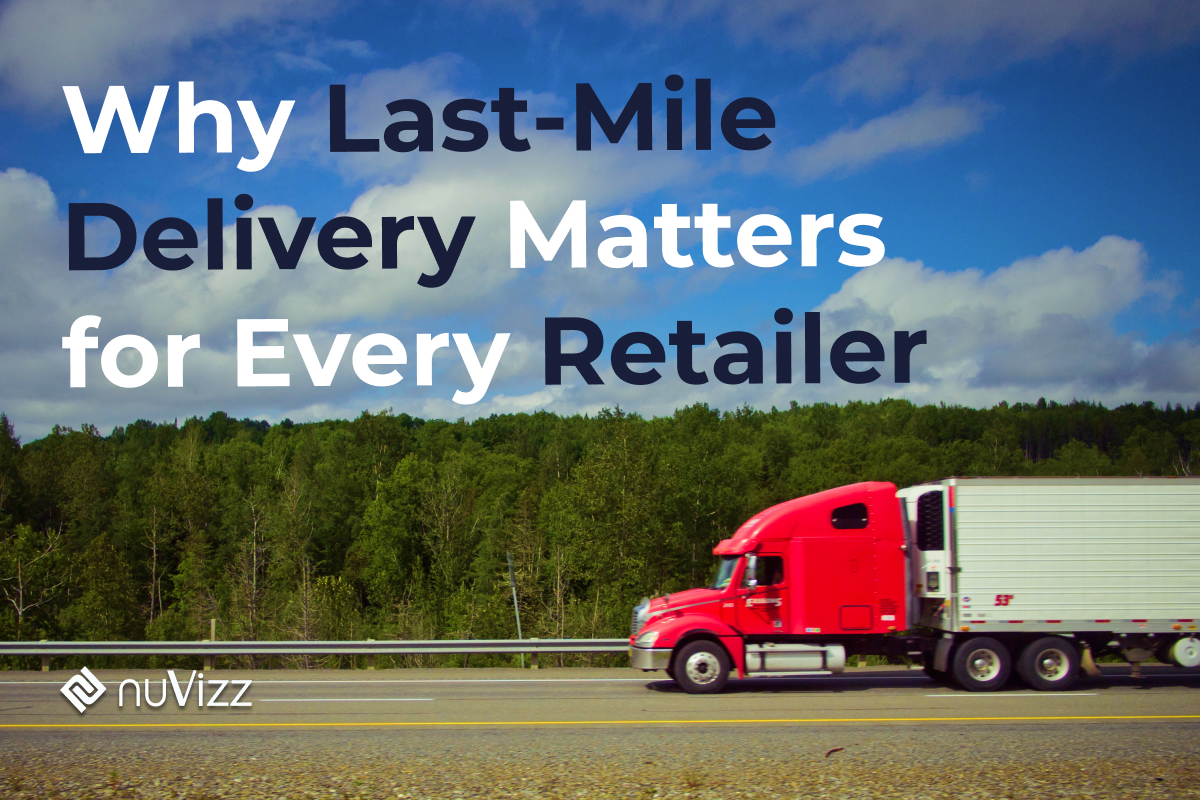For retailers, smooth and efficient last-mile delivery is now crucial for keeping customers happy and building brand loyalty.
The last mile delivery process is the final step of moving goods from a distribution hub to customers or retail outlets, often the most challenging and expensive part of logistics.
With online shopping and same-day delivery now standard, retailers need to optimize Last Mile logistics to stay competitive.
In retail, understanding and mastering last-mile delivery is crucial, as every delivery directly impacts customer perception.
This article examines the role of Last-Mile delivery in retail, delves into common challenges, and highlights future innovations shaping last-mile solutions for retailers.
What is Last-Mile Delivery?
In simple terms, Last-Mile delivery refers to the movement of goods from a distribution center to the final destination, typically the customer’s doorstep. For retailers, this stage is crucial because it serves as the last point of contact with the customer, making it the most visible part of the Last Mile delivery supply chain. A smooth final-mile delivery experience can boost customer satisfaction, while a poorly executed one can erode trust.
This segment of the Last Mile delivery process is characterized by complex logistics, high customer expectations, and significant costs. The uniqueness of last-mile delivery logistics lies in its proximity to the customer; deliveries need to be precise, timely, and convenient. However, several Last Mile delivery problems hinder this process, such as traffic congestion, complex routing needs, and cost pressures. By leveraging a specialized Last Mile delivery platform, retailers can tackle these challenges, optimize delivery efficiency, and meet customer demands.
Why Last-Mile Delivery Matters for Retailers
Last-mile delivery isn’t just about getting packages delivered to customers—it’s about creating a seamless experience that reflects positively on the retailer’s brand. Here’s why last-mile delivery is a game-changer for retailers:
⦁ Reducing Call Center Overheads:
Retailers can minimize the burden on their call centers by enabling customers to schedule their own delivery appointments through automated systems. Self-service appointment scheduling reduces the volume of support inquiries, allowing customer service teams to focus on more complex issues.
⦁ Lowering Missed Appointments and Re-Deliveries:
Failed deliveries lead to additional costs and decreased operational efficiency. Retailers using an effective Last Mile delivery solution can optimize delivery routes and scheduling to ensure that deliveries are completed successfully the first time. Minimizing failed delivery attempts reduces the need for costly re-deliveries and enhances customer satisfaction.
⦁ Delighting Customers Through Personalized Service:
Customer expectations are higher than ever, with many expecting swift, reliable deliveries that fit their schedules. Retailers who excel in Last Mile logistics and provide options such as flexible delivery times and real-time tracking not only enhance customer satisfaction but also build brand loyalty.
⦁ Optimizing Driver and Vehicle Utilization:
Effective Last Mile delivery logistics isn’t just about fast delivery; it’s also about maximizing resources. By optimizing the use of driver and vehicle assets, retailers can reduce operational expenses and ensure timely deliveries, even during peak demand.
⦁ Capturing Customer Feedback for Continuous Improvement:
Customer feedback is invaluable for improving delivery services. By incorporating automated surveys post-delivery, retailers can capture insights into the customer experience, identify areas for improvement, and maintain high levels of customer satisfaction.
Challenges in Last-Mile Delivery for Retailers
While last-mile delivery is crucial, it presents several challenges that can impact a retailer’s bottom line and customer satisfaction levels:
⦁ High Delivery Costs:
The last mile is the most costly part of the delivery process, often accounting for over 50% of the total shipping cost. These high Last Mile delivery costs are driven by expenses such as fuel, labor, and the need for specialized equipment. Retailers must find innovative ways to manage these costs while maintaining service quality.
⦁ Traffic and Routing Complications:
Urban congestion and rural distances can create significant delays in the Last Mile delivery logistics process. Congestion in metropolitan areas and the complexity of rural routes make it difficult to adhere to strict delivery timelines. Advanced route optimization tools are crucial for retailers who need to overcome these obstacles, providing more efficient routing options to ensure timely deliveries.
⦁ Failed Deliveries and Product Returns:
Missed delivery attempts are common in the last mile and come with added costs. Each failed attempt adds strain to the retailer’s resources and can lead to customer dissatisfaction. Failed deliveries also increase the risk of returns, which create additional costs and complexity. Retailers must use predictive analytics and enhanced Last Mile delivery platforms to reduce these instances and deliver on customer expectations.
The Future of Last-Mile Delivery in Retail
For retailers, Last-Mile delivery is entering a transformative phase driven by advanced logistics solutions. With growing customer demands for fast and accurate deliveries, retailers are embracing technology to elevate Last Mile delivery logistics. Key innovations, including route optimization, robodispatch, real-time visibility, automated billing and settlement, and customer engagement tools, are defining the future of Last Mile delivery solutions. Here’s how these features are shaping last-mile delivery:
⦁ Route Optimization:
Optimizing delivery routes is crucial for minimizing fuel costs, reducing Last Mile delivery costs, and enhancing overall efficiency. By calculating the best routes based on variables like traffic, weather, delivery windows, and order density, route optimization enables retailers to fulfill more orders in less time. For retailers handling high volumes or managing peak demand, route optimization provides a cost-effective way to meet tight delivery schedules.
⦁ Robodispatch:
Robodispatch automates the assignment of deliveries to drivers, ensuring that each task is matched to the best-suited resources. By leveraging AI and real-time data, Robodispatch optimizes driver schedules, manages vehicle capacity, and adjusts dynamically to changes, like last-minute orders or traffic delays. Retailers benefit from faster dispatch times, reduced operational costs, and improved flexibility, making it easier to handle both planned and unplanned deliveries.
⦁ Real-Time Visibility:
Today’s customers expect transparency in final-mile delivery, wanting updates on the status and location of their orders. Real-time visibility tools allow retailers and customers alike to track deliveries in real time, providing a higher level of assurance and satisfaction. This feature also empowers retailers to monitor deliveries proactively, enabling them to address any potential delays before they impact the customer experience.
⦁ Automated Billing and Settlement:
Efficient billing and settlement processes are essential for retailers with complex last-mile operations. Automated billing and settlement features streamline these financial processes by ensuring accurate tracking of Last Mile delivery costs, generating invoices, and managing payments between stakeholders. This automation reduces manual work, improves accuracy, and accelerates financial reconciliation, helping retailers keep costs under control.
⦁ Enhanced Customer Communication and Engagement:
In the last mile, customer engagement is key to satisfaction and loyalty. Retailers are increasingly using automated notifications and self-service options, like delivery rescheduling and personalized delivery updates, to keep customers informed and engaged. Post-delivery feedback surveys also capture customer sentiments, providing valuable insights that help retailers refine their Last Mile delivery platform and improve service quality.
⦁ Data-Driven Decision Making:
Leveraging data analytics in Last Mile delivery logistics is becoming standard practice. With access to rich data on delivery performance, customer feedback, and route efficiency, retailers can make data-driven decisions to continuously optimize their Last Mile delivery process. Analytics enable retailers to identify trends, anticipate demand spikes, and adjust strategies accordingly, leading to smarter and more responsive logistics.
These features, powered by advanced technology, mark a new era for Last Mile delivery logistics. By adopting these innovations, retailers can stay competitive in a dynamic marketplace, meet customer expectations, and drive operational efficiency. As Last Mile delivery solutions evolve, retailers who leverage these tools will be well-positioned to succeed in the future of e-commerce and retail logistics.
For retailers, last-mile delivery is not just a logistics task—it’s a strategic opportunity to build stronger relationships with customers. By overcoming Last Mile delivery problems and leveraging innovative Last Mile delivery platforms, retailers can meet high customer expectations while maintaining profitability. Retailers that prioritize last-mile delivery solutions tailored to their needs will continue to build customer loyalty and stand out in an increasingly competitive market.
About nuVizz
nuVizz is a leader in Last Mile delivery logistics, providing visibility across multiple delivery partners and supporting retailers in streamlining their delivery operations. The platform offers order visibility across multiple terminals or hubs, enabling retailers to manage complex logistics seamlessly. Additionally, automated customer satisfaction surveys empower retailers to capture essential feedback, continuously improving the delivery experience.

